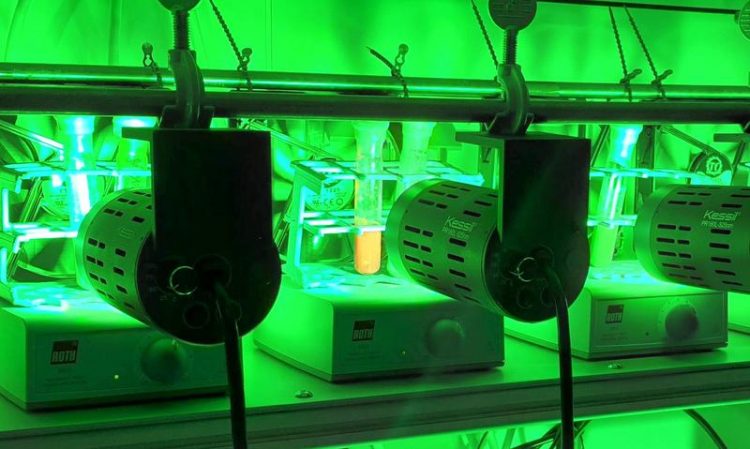Put into the right light – Reproducible and sustainable coupling reactions

Photochemical carbon-nitrogen cross-couplings can be dramatically improved by the choice of the light source ©Bartholomäus Pieber
A team of researchers reports in the journal Nature Catalysis that sustainable carbon-nitrogen cross-couplings can be performed using simple nickel salts, carbon nitrides and light.
The chemists study the use of cost-effective and reproducible semiconductors as photocatalysts in coupling reactions.
Carbon-nitrogen cross-couplings are among the most important chemical reactions for the production of active pharmaceutical ingredients, crop protection agents and organic materials. In these reactions, two molecular building blocks are selectively linked together with the aid of a catalyst.
Palladium compounds, which are considered excellent catalysts, are normally used for this purpose. However, due to the low abundance of this precious metal, these are expensive and not sustainable. Nickel is intensively studied as an alternative. However, this usually requires complex nickel complexes, strong bases or high temperatures.
Activation of simple nickel compounds by light and photocatalysts
These disadvantages can be avoided by activating simple nickel compounds with light and a photocatalyst. Suitable photocatalysts usually consist of rare and expensive precious metals such as iridium and ruthenium.
In addition, the range of applications of these methods is limited and incomplete reactions as well as irreproducible results are observed.
Precious metal-free methods for reproducible carbon-nitrogen cross-coupling
In the course of their efforts to replace iridium and ruthenium photocatalysts with carbon nitrides, the chemists led by Bartholomäus Pieber discovered that the limitations and poor reproducibility are due to the destruction of the nickel catalyst, which can also lead to the deactivation of the photocatalyst.
A careful analysis of these reactions enabled the scientists to prevent the destruction of the catalysts by selecting suitable light sources, changing the concentration or adding stabilizing additives. This has considerably expanded the range of applications for this reaction.
Bartholomäus Pieber, leading scientist of the research group “Catalysis”, emphasizes:
“The developed, precious metal-free coupling protocols open the way to cost-effective, sustainable and above all reproducible carbon-nitrogen cross-couplings, which can also be carried out with sunlight as an energy source. We will next test our methodology for the production of active pharmaceutical ingredients”.
Dr. Bartholomäus Pieber
Bartholomaeus.Pieber@mpikg.mpg.de
Gisbertz, S., Reischauer, S. & Pieber, B.: Overcoming limitations in dual photoredox/nickel-catalysed C–N cross-couplings due to catalyst deactivation. Nat Catal (2020). https://doi.org/10.1038/s41929-020-0473-6
Media Contact
All latest news from the category: Life Sciences and Chemistry
Articles and reports from the Life Sciences and chemistry area deal with applied and basic research into modern biology, chemistry and human medicine.
Valuable information can be found on a range of life sciences fields including bacteriology, biochemistry, bionics, bioinformatics, biophysics, biotechnology, genetics, geobotany, human biology, marine biology, microbiology, molecular biology, cellular biology, zoology, bioinorganic chemistry, microchemistry and environmental chemistry.
Newest articles

Pinpointing hydrogen isotopes in titanium hydride nanofilms
Although it is the smallest and lightest atom, hydrogen can have a big impact by infiltrating other materials and affecting their properties, such as superconductivity and metal-insulator-transitions. Now, researchers from…

A new way of entangling light and sound
For a wide variety of emerging quantum technologies, such as secure quantum communications and quantum computing, quantum entanglement is a prerequisite. Scientists at the Max-Planck-Institute for the Science of Light…

Telescope for NASA’s Roman Mission complete, delivered to Goddard
NASA’s Nancy Grace Roman Space Telescope is one giant step closer to unlocking the mysteries of the universe. The mission has now received its final major delivery: the Optical Telescope…



